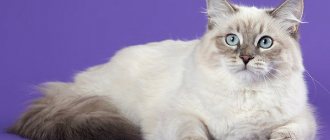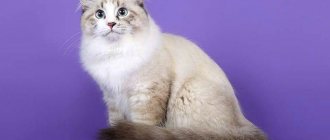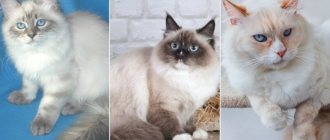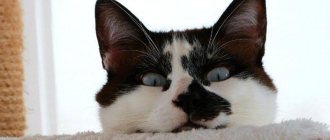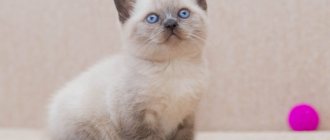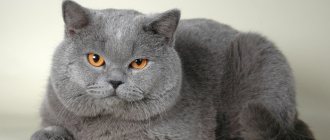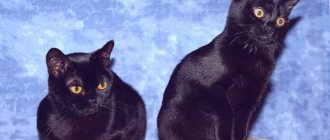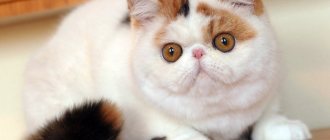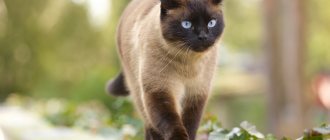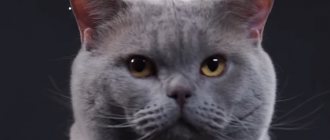The Neva Masquerade cat is one of the varieties of Siberian cats. They are distinguished by a special color - color-point with blue eyes of an intense shade. They were affectionately nicknamed “Nevaks” among the people and among specialists.
These cats are valued for their bright appearance, good health, character, and hypoallergenicity. There is a description of the Neva masquerade cat, which must correspond to a purebred individual with a good pedigree.
Main characteristics
There are strict breed standards, which are much the same as for Siberian cats, but there are some differences.
- Body. The cat is large in size and weight. The male reaches 8-10 kg, and the females – 6-7.
- The body has developed muscles with strong bones. The body itself is of medium length, dense.
- The animal's paws are proportional to the body.
- Head. The cat's skull is trapezoidal in shape and has a low forehead.
- The neck is short but strong. The profile of the cat is smooth and has indentations.
- Ears. Medium in size, slightly inclined, with a large wide base. There are small tassels or brushes at the ends.
- Eyes. Slightly slanted, round cut. The color of the iris is strictly blue.
- Tail. Wide and fluffy.
- Wool. Has medium length. On the sides of the body it has a soft but dense structure. It does not fit tightly to the body. The animal has expressive pants and a collar.
Weak bones, a fragile neck, and thin paws are not allowed. There are other signs that do not meet the standards:
- narrow muzzle with a straight, slightly elongated profile;
- poorly developed cheekbones;
- small, deep-set eyes;
- small ears with a fluffy border on the inside;
- short tail with a pointed tip;
- absence or weak expression of the undercoat, or if it is too long.
The disadvantages of the breed are the excessively miniature size of the individual, too thin and light bones.
Interesting read: everything about the Ragdoll breed.
Colors of the Neva Masquerade breed
According to the standards, the following colors of Neva Masquerade are allowed:
- seal point;
- seal tabby point;
- blue point;
- red point;
- turtle
The first two types of color are the most common among this breed, and the latter is found only in cats, but not in cats.
- seal point and seal tabby point (the most common);
- blue point;
- red point;
- tortoiseshell point (found only in females).
There are a variety of smoky colors:
- seal-smoky or smoky;
- blue smoke or blue color;
- red smoky or red coat color;
- black point or black smoky color.
All colors that are found in the Neva breed are points. There are other common colors of these animals:
- blue;
- ginger;
- black;
- carnival;
- white;
- festival
Kittens of the masquerade breed are born only white. Dark spots on them appear later, which is explained by the temperature sensitivity gene. A cat's body produces special pigments that affect the color of its coat. Only those hairs that are influenced by low ambient temperatures acquire a particular shade.
Blue point cat
Red point
Black point masquerade
Neva tortoiseshell color.
Red color.
Black Neva kitten
Compare breeds: everything about the Norwegian forest cat.
History of the breed
The Neva cat belongs to the young breeds of Russian representatives of the family. Feline. Its exact origin is hidden under a veil of secrecy. According to one version, there are genes of a Siamese cat in her blood; according to another, she could not do without the participation of a Persian color point.
The St. Petersburg masquerade cat has its main origin from Siberian cats, which are the ancestors of many breeds. It is classified as indigenous because its appearance is influenced by climatic conditions. The new breed first appeared in public at an exhibition of felines in St. Petersburg in 1988.
The Neva Masquerade received official recognition in 1992 and was registered as a separate breed by the FIFE and WCF associations. Since the breed was formed on the banks of the Neva and here it acquired a “carnival costume”, a beautiful name for the cat breed was born - Neva Masquerade. She quickly gained popularity and began to appear more and more often at exhibitions, demonstrating her visual attractiveness.
For information: Some felinologists still classify the masquerade cat as a representative of Siberians with an unusual color and expressive coloring of the face, refusing to recognize it as a separate breed.
Seal-tabby-point
Red Point
Blue point photo
Character and characteristics of upbringing
The ideal owner of this breed is a large family with children and other animals. This breed has a calm, easy-going character; they are kind and not vindictive. They cannot stand the familiar attitude towards themselves from guests, but they will not bite or scratch.
The attitude towards the owners is the opposite - affection, tenderness and even, to some extent, care when it comes to children. They especially like to sleep on the master's bed, with a person. If this is undesirable for a person, a kitten should be accustomed to its sleeping place immediately after it gets into the house. Education must begin at a young age. This process is quick and does not cause any particular difficulties. This applies primarily to the tray, scratching post, and grooming procedures.
The Neva Masquerade cat is endowed with good manners, high intelligence, and memory. If the owner returns from work worried, stressed or depressed, the cat will do its best to smooth it out. The masquerade cat gets along well with small children and can even show care and responsibility with them. They have a great time together playing with each other.
The animal does not use its claws and teeth; it is incapable of harming the baby. This applies even to those cases when the child is too “intrusive.” Neva cats are characterized by their courage. In the event of a threat to the health or life of themselves or their owners, they will not think twice about fighting even with large dogs, and can emerge victorious from this fight.
The Siberian cat is a direct relative of the Neva cat.
Interesting facts about the breed
Siberian color dogs live with some Russian celebrities. Ballerina Anastasia Volochkova adores the nevaka Georges, and TV presenter Tatyana Pushkina is attached to the cat Stesha. The representative of the breed, the cat Dorofey, feels great with the Prime Minister of the Russian Federation D. Medvedev. Having received the title of “the first cat of the country,” he boldly entered into a duel with the furry pet of M. Gorbachev, who lived next door.
D. Medvedev presented one of the descendants of his Nevaks as a gift to Tarja Halonen, the former head of Finland. Russian President Vladimir Putin made a living gift to the governor of the Japanese prefecture, presenting him with a Siberian Color Point.
The fame of Siberian masquerade parties crossed the borders of Russia and reached Hollywood. Here the Nevaks also rose to the occasion: a cat named Blue-Eyed Angel starred in the film “Nine Lives.” In the TV show “Planet of Cats” the Neva Masquerade is also one of the heroines.
I would like to dwell on the advantages and disadvantages of the Neva Masquerade breed. Among the undeniable advantages it should be noted:
- grace and beautiful, elegant appearance;
- good adaptation to new conditions;
- friendly character traits;
- excellent health and long life expectancy.
Among the shortcomings in the arsenal of the Nevaks are signs of phlegmatism and a stubborn disposition. They require a lot of space and space to live. Fur coat care is an important part of keeping a furry pet. Otherwise the breed is cute and popular. Blue-eyed animals native to the Neva are devoted friends and the pride of their owners.
Care and maintenance
The Neva Masquerade cat sheds twice a year, and care does not involve particularly complex procedures. Thick fur has no problems; you just need to brush it regularly. By itself, it does not roll, does not fall off, and tangles do not form on it. During the molting period, if these manipulations are not carried out, hairs will be everywhere - on clothes, furniture, carpet.
To prevent the pet's color from becoming darker, the animal needs to create warm conditions in the apartment. Such cats have good health, but it is necessary to adhere to the principles of proper nutrition and adherence to a certain diet.
Failure to do this increases the risk of certain health problems. As a ready-made food, it is important to choose premium and super premium food. A cat's diet should contain the micro- and macroelements, vitamins, and minerals they need.
Cats should not be fed food intended for humans - food from the common table can be harmful to health. The basis should be dietary lean meat. It can be boiled or raw, but heat-treated to reduce the risk of helminth infection.
It can be done either by deep freezing or scalding with boiling water before serving. Vegetables and cereal porridge are suitable as a side dish. Not recommended for cats:
- salt;
- sweet;
- smoked meats;
- fatty foods;
- fish;
- seafood.
Kittens from the same litter.
Small kittens receive food five times a day, for adult cats the frequency of feeding is 2-3 times. This breed is not prone to gaining excess weight, but it is better to feed it in portions of 150 grams. Neva cats like to walk in the fresh air. Even severe frosts are not a problem for them, since they are a type of Siberian cat that is not afraid of the cold. By nature they are good hunters, hardy, and have good reactions. If walking around the yard causes stress for your pet, it is better to avoid them.
Grooming should be done at least several times a week. During the molting period, it is better to brush daily. For this purpose, combs with frequent and rare teeth, soft rubber or silicone scratchers are suitable. Since the Siberian cat is a direct relative, these animals tolerate frost well. This is due to evolution and adaptation to the harsh climatic conditions of the region where they appeared.
Health and illness
Cats of this breed live on average 10-13 years. If a pet receives proper nutrition, has vaccinations, and proper care, it can live much longer, up to 20 years or more. The masquerade breed has strong immunity and generally good health from birth.
They most often suffer from diseases that also occur in other felines, such as cardiomyopathy. The disease may not manifest itself in any way in childhood, but become noticeable only with age and even cause sudden death.
Torty point
This is the name of a color beloved by many, where black and red spots are mixed on the coat. They say that such “variegated” cats bring happiness. The tortie point, like all color points, has colored only the face, ears, limbs and tail. It can be difficult to find red spots on the ears and heels of a small kitten, which introduces some difficulty in determining the color. In addition, these spots have a habit of increasing and changing shape with age, and you will never guess what your turtle kitten will look like in a year, but there are no absolutely identical turtles in the world, each is unique in its own way. Only cats are turtles.
How to choose a kitten
It is extremely difficult to recognize the future color of a masquerade breed kitten. Color is determined by external conditions, especially ambient temperature. Two identical kittens, but living in different conditions, will have different colors.
Its final color is formed only at the age of 4-5 years. This circumstance makes it difficult for them to participate in exhibitions and international competitions. When choosing a kitten, you need to know for what purpose this is happening - further breeding of the breed, participation in exhibitions, or simply as a pet pet.
After the purchase, the question arises - what to name the Neva Masquerade kitten. Usually, nicknames for cats are chosen either from options that are pleasant to the ear, or based on the characteristics of the animal’s appearance, character, and habits. It’s worth looking at the table of popular cat names; perhaps the owner will like some of the options given.
Popular nicknames for cats.
You should not choose a kitten solely based on photographs. You must personally visit the nursery and see the animal with your own eyes. An ideal kitten should have all the necessary documents, good health, be playful, curious, and show interest in people.
How much does the Neva Masquerade cost?
The cost of a kitten from professional breeders starts from 20 thousand rubles. It is extremely difficult to determine whether an individual belongs to the breed or show class at this age. Prices may vary depending on the region and range from 10 to 50 thousand rubles. This is the cost of representatives of the pet class and breed.
The former are of no interest to those who want to start breeding and distributing the breed. Breeds are valued most of all as owners of breed standards that they will pass on to their offspring. A show class kitten can cost more than 35 rubles and even more, especially tortoiseshells.
Breeding
Masquerade cats are not allowed to breed with other cat breeds. Currently, the popularity of this breed is only growing; you need to look for a partner for mating only among your own breed, which can be found in specialized nurseries.
